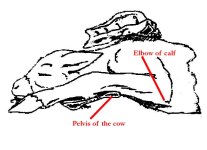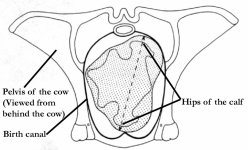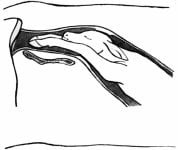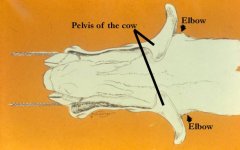I really struggle with this birth weight thing. That said, I do believe that we really do need to address it and get them under control somewhat.I agree fully that we need to get the monster birth weights under control. My issue is that I am not convinced that if we were to get all Shorthorn calves to be born under say, 100 lb,that we would not have a new set of problems develop. I will give you an example of what I mean.
In our recent Sun Country Bull Sale, we had bulls from 5 breeders that were all fed together since last October, and we tested all the bulls for performance as well as did all the ultrasound testing as well for carcass traits. It was an interesting comparison of bulls from several bloodlines. All the bulls had been born unassisted at birth. BWs were from 71 lb to 113 lb. In the performance test, not one bull in the bottom half of the birth weights indexed over 100 for ADG or WPDA. I will say it again.... Not One. I also noticed that the best carcasses were found on the bulls with in the bulls with higher BWs. This one surprised me... and maybe it is coincidence.I will be watching this one in future tests for sure.
All this indicates to me that there is some magical line where we can keep performance and carcass quality along with moderate birth weights and calving ease. I will also say that there is a big difference between BW and calving ease, and oftentimes they really are not closely related.
I personally decided 8 years ago that I would not keep any bull calf that weighed over 110 lb or needed assistance at birth. Most of my bulls sell to commercial producers and I have not had one complaint about calving problems since I did this. I have two commercial producers who have each purchased over 12 bulls from me in the last 8 years. Both purchased more bulls in our recent bull sale. Both told me they have no calving issues with our bulls. Several of the bulls they have purchased have been 100 to 110 lb.
I had a lot of interest in the Salute bull we had in our sale that sold for $20,000. Almost everyone was concerned about his birth weight of 105 lb. I explained to everyone, that his recip mother was a very tiny Angus cow, and she calved him in literally minutes. I was doing chores when she started calving and I walked through the cows to see if any more were calving outside, and when I got back to the barn , this calf was already standing and trying to nurse.This was literally a few minutes later. They don't get born any easier than this. Another bull buyer, ranches in one of the most rugged areas of N America. He selected my highest BW bull. He said that BWs were not as much an issue with him but he wanted to know if the bull was born unassisted at birth. He said he was more concerned about pounds of calf he sold than birth weights. Almost all his calves are born unseen by anyone.
I recently had a conversation with one of the largest order buyers in this country, and he said that it is much harder today to assemble pot loads of very uniform feeder calves than it was 20 years ago. He said that he thinks that part of the reason for this is the industry's obsession on low birth weights. I was very surprised by this statement. I asked him what he meant, and he said that he thinks we are producing shorter made calves today than we did a few years ago. His thoughts were that too many commercial producers were only selecting bulls based on BW, and some of the lower BW bulls are too short made. I never thought about this, but I do think he has a point. My point is, there are several other factors that affect calving ease other than birth weight. My vets tell me they have done several C- sections this spring on calves that weighed under 90 lbs. My question is why is this happening? I am convinced that selection on BW alone for too many generations also, is selection for smaller pelvic area.There are some studies that show this as well. So..... I think we all need to be careful what we are wishing for, in regards to birth weights.
I saw this in our own sale. Before our sale started, one of my bull buyers asked me about their bull selections. This couple had a sale catalogue in which they had marked every low BW bull and in my opinion, they ended up buying our poorest quality bulls. I tried to suggest other bulls to them, but they said they were concerned about these bulls BWs, despite the fact that some of the better bulls were less than 10 lb heavier at birth. No selection trait was talked about more than the bulls BW, when I talked to potential bull buyers. I think it came up in every conversation. Some did not come to the sale because they felt our birth weights were too high. That is fine, as I doubt if some of these producers have any idea what a 80 lb calf looks like.
To me, BW is one of the most distorted numbers we use in this industry. I do not believe the BWs reported by some breeders are accurate. I have a good friend who raises Angus cattle, and he is diligent in weighing every calf at birth. He says he cannot get BWs as low as some other breeders despite using the same genetics. He had BWs this year as high as 120 lb from Angus bulls from reputation bloodlines. He had lots of calves over 100 lbs. I don`t think his management is much different than most other breeders. This said, we also need to remember that BW is not just the sires fault, but the bull will get blamed for everything. Feed, enviromental conditions, materanal genetics, exercise, and several other factors can affect the BW of the calf.It is not just the bull who affects the BW.
I guess my point is, that we all need to put a little thought into what we want to accomplish with our breeding selections. I am very concerned that we are heading down a road where there is too little thought as to where we are going to end up. I try to select for calving ease more than I do for BW. It seems to be working here at least. As of this morning, I have 138 calves on the ground. I have assisted one birth other than 6 malpresentations. ( Two backwards and four legs back... all four of these were on heifers I was keeping for a friend who is battling cancer... not sure why this happened). All our commercial cows and heifers are bred to Shorthorn bulls ( 5 different sires), and every one of them calved unassisted. To me, I am beginning to wonder if this BW issue is as big as it is made out to be... or if it is just a little overblown. We need to be careful that, in the process of trying to moderate BW, that we do not eliminate some other traits this breed excells at. Remember, on average, a Shorthorn has approximately two square inches more pelvic area than other British breeds. Do we want to lose this .




